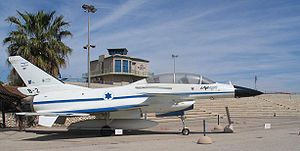IAI Lavi
| Lavi | |
|---|---|
 |
|
| Lavi B-02 prototype | |
| Role | Multirole fighter |
| Manufacturer | Israel Aircraft Industries |
| First flight | 31 December 1986 |
| Status | Canceled in August 1987 |
| Number built | 3 prototypes |
| Program cost | US$1.5 billion |
| Unit cost |
$11 million (projected)
|
|
|
|
|
|
|
|
|
The IAI Lavi (Hebrew: לביא, "Young Lion") was a single-engined fourth-generation multirole jet fighter developed in Israel in the 1980s. Developed by Israel Aircraft Industries (IAI), the choice to develop the Lavi was controversial, both with the Israeli public due to the enormous associated costs and particularly with the U.S. government due to competition with American jets on the export market. These issues contributed to the ultimate cancellation of the aircraft during the flight testing phase of development by the Israeli government in August 1987.
The Lavi was planned to be the mainstay of the Israeli Air Force, and considerable export sales for the aircraft had been forecast. The uniqueness of its design was in the combination of a small, aerodynamic, highly maneuverable plane, with sophisticated, software-rich systems, low armed drag, and the ability to carry a large payload at high speed and over long distances. As of 2012, two of the prototypes have been preserved, and have been placed on public display.
Conceptually, the Lavi had its origins in the idea espoused by IAF commander and Minister of Defence Ezer Weizman that Israel's combat aircraft should fall into 'two-tiers' – a small number of high performance aircraft and a larger bulk with less sophistication and complexity. In the mid-1970s, the plane that was to become the Lavi was meant to be a multirole fighter-bomber to replace aging IAF aircraft such as the Douglas A-4 Skyhawk and IAI Kfir; however continuous revisions of the proposed aircraft led to the incorporation of more advanced technologies and ideas to produce an ambitious aircraft in the class of the American General Dynamics F-16. The IAF was estimated to have a requirement for 300 aircraft, 60 of which were expected to be combat-capable two-seat trainers.
In February 1980, a milestone towards the development of the Lavi occurred when the Israeli government granted its authorisation for the IAF to present its list of technical specifications and requirements which sought the IAF's envisioned future fighter aircraft. While the Lavi was heavily influenced by these requirements, it was also affected by concepts of the wider strategic situation that Israel was confronted by. Menachem Eine, who headed the Lavi program, concluded that any proposed aircraft would be subject to a substantially greater threat than any envisioned US fighter, and would have to be developed with these threats in mind. Eine observed that the aircraft needed to not only take into consideration the best Soviet armaments that would be potentially faced in combat, but the best American equipment as well, as both Egypt and Saudi Arabia were being supplied with modern American fighter aircraft.
...
Wikipedia
